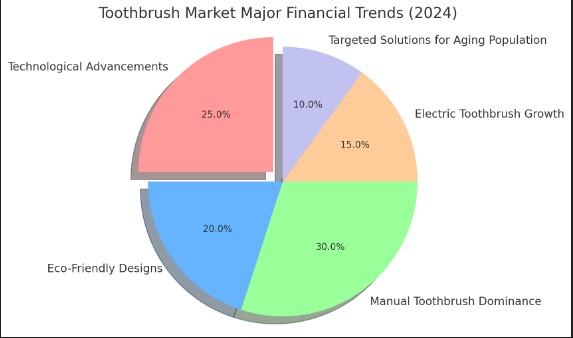The Toothbrush Industry: A Comprehensive Overview up to 2032
The toothbrush industry, the cornerstone of oral hygiene, represents an attractive sector from a financial perspective. Driven by health consciousness, technological innovation, and a growing global population, the industry is a mix of consistent demand and innovation-driven growth. This article explores the financial aspects of the toothbrush market, including market size, trends, investment opportunities, and challenges.
Market Overview and Financial Size of Toothbrush
The toothbrush market has witnessed steady growth, with the global market size expected to reach $7.07 billion in 2023 and $10.87 billion by 2032. The compound annual growth rate (CAGR) of approximately 6.3% highlights the sustained demand for both manual and electric toothbrushes.
Take a look at the Current Toothbrush market’s major financial trend(2024)

1. Revenue Streams
- Manual toothbrushes: account for a large share in sales due to affordability and wide availability.
- Electric toothbrushes: although expensive, have seen rapid growth due to increasing consumer awareness and technological features.
2. Regional Analysis
- North America is leading the market with high disposable income and awareness about dental health.
- Emerging markets in Asia-Pacific present attractive growth opportunities with increasing urbanization and improved healthcare access.
Major Financial Trends
Major financial trends show variation with innovation and R&D towards investment to grow and earn.
Let’s understand this in three parts:
1. Variation on Premium Products
- The market is witnessing a trend towards higher-margin products such as electric toothbrushes with smart technology.
- Subscription models provide a periodical revenue stream.
2. Innovation and R&D Investment revolutionized this Industry
- Companies are investing heavily in innovation such as AI-enabled toothbrushes and eco-friendly materials to meet the growing demand for sustainability and convenience.
3. Mergers and Acquisitions
- Recent consolidation in the industry indicates efforts to increase market share. For example, the acquisition of niche brands with strong regional presence has become a strategy for global expansion.
Profit Margin and Cost Considerations
1. Production Cost
- Manual toothbrush: Low production costs but low margins due to competition.
- Electric toothbrush: Higher cost (materials, technology, and compliance) but better profit margins.
2. Marketing expenses
- Aggressive marketing campaigns are important for brand differentiation, especially in the crowded electric toothbrush segment.
- Influencer partnerships and digital advertising are increasing operating expenses, but also increasing brand visibility.
Investment opportunities have Risen
1. Technology Integration
- Adopting smart toothbrushes with Bluetooth connectivity, app integration, and AI analytics has created a niche but profitable segment.
2. Eco-Friendly Products
- Biodegradable toothbrushes and bamboo-based models meet the growing demand for sustainable alternatives while attracting environmentally conscious consumers.
3. Subscription Services
- Recurring revenue through the subscription model for electric toothbrush head replacement provides a predictable income source for investors.
4. Emerging Markets
- Companies focusing on affordable but sustainable models in regions such as India, China, and Southeast Asia have untapped growth potential.
Challenges and financial risks
1. Pricing Pressure
- Intense competition among brands often leads to price wars, affecting profit margins, especially for manual toothbrushes.
2. Raw Material Cost
- Fluctuations in prices of plastics, electronics, and durable materials may increase manufacturing costs.
3. Regulatory compliance
- Meeting health and safety standards in different global markets increases operating costs.
4. Economic instability
- Global economic uncertainties may impact consumer spending on premium products such as electric toothbrushes.
The toothbrush market will benefit from technological advancements and changes in consumer preferences. Companies that prioritize sustainability, affordability and technology-driven solutions are likely to gain a competitive edge. Investors should focus on companies with diverse product ranges, strong presence in emerging markets and strong R&D initiatives.
From a financial perspective, the toothbrush industry is more than just a consumer goods sector, It is a dynamic market with diverse investment avenues and a stable demand base. By balancing innovation and cost-efficiency, stakeholders can unlock significant growth and profitability in this essential healthcare sector.
“Investing in toothbrushes is investing in everyday essentials—a symbol of security, sustainability, and the unshakable demand for health and hygiene.”
Aashish Kuumar
You can also share your own views in the comments or write us @hevensh05@gmail.com and we would be really glad to share information and views on our website.

Pingback: Should We Invest in Cryptocurrencies in 2025 ? - Hevensh.com